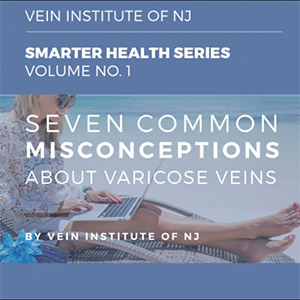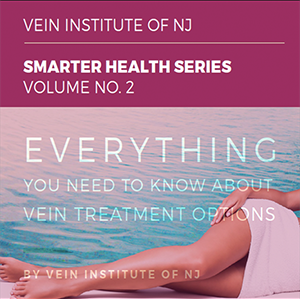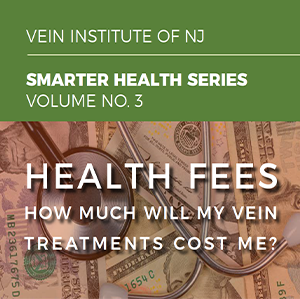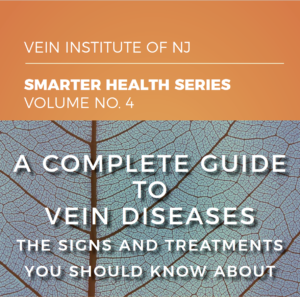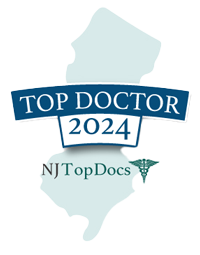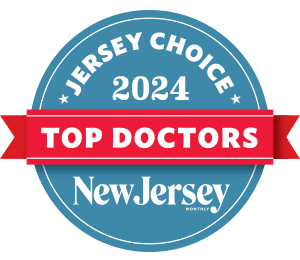Frequently Asked Questions
Download our latest eBooks
Click on a book to download and get the facts
Vein Condition Questions
- What is the difference between spider veins and varicose veins?
- What exactly is venous insufficiency?
- Are varicose veins merely a cosmetic problem?
- What are the risk factors for developing vein disease?
- Can varicose veins or vein disease be prevented?
- What is Deep Vein Thrombosis (DVT)?
- What is a Vascular surgeon and why use one for vein procedures?
Injection Sclerotherapy Questions
- What is sclerotherapy?
- Will it hurt?
- Is this treatment permanent?
- How many treatments will I need?
- Will I need to take time off of work?
- What is the cost?
Vein Condition Questions
Q. What is the difference between spider veins and varicose veins?
Spider veins are small red, blue or purple blood vessels on the surface of the skin. Varicose veins are abnormal veins that have become swollen, enlarged and ropey. Varicose veins are usually a result of defective valves inside the vein. This condition is known as venous insufficiency. Together, spider veins and bulging varicose veins comprise the most common circulatory problem of the lower extremities. It is estimated that spider veins and varicose veins affect 80 million people in the United States.
Q. What exactly is venous insufficiency?
Venous insufficiency is the abnormal backward flow of blood through the leg veins. Normally as we walk, our calf muscles contract pushing blood up our legs. Inside these leg veins are one-way valves that do not allow the blood to come back down. When these valves malfunction, gravity pulls the blood backward down the vein. The backward flow of blood generates high pressure inside the vein causing the vein walls to stretch until the vein bulges and becomes varicose.
Q. Are varicose veins merely a cosmetic problem?
People significantly affected by varicose vein disease can have varying degrees of discomfort including pain, aching, throbbing, and leg heaviness. Unfortunately, people often wait to seek treatment and are at increased risk of developing additional complications including swelling, skin changes, phlebitis and ulceration.
Q. What are the risk factors for developing vein disease?
Heredity or a genetic weakness of the vein wall valves and circulating hormones that relax vein wall smooth muscle are the most common causes of varicose veins disease. Women have high levels of such a hormone (progesterone). Pregnancy, obesity, hormone replacement therapy, oral contraceptive pills as well as occupations that require prolonged standing or sitting are additional causes of varicose veins. Since females usually have multiple risk factors for development of varicose veins, about 75% of the people with varicose veins are women.
Q. Can varicose veins or vein disease be prevented?
Unfortunately, there is no certain way to prevent varicose veins, if a person has inherited a tendency to develop them. However, the use of medical grade graduated compression stockings, regular walking or other exercise regimens, weight management, and avoidance of tight, restrictive clothing all may help discourage the formation of dilated blood vessels or reduce the severity of the problem.
Q. What is Deep Vein Thrombosis (DVT)?
Deep Vein Thrombosis is a serious medical condition that occurs when a blood clot forms in a deep vein. Left untreated, the clot can break loose and travel to the lungs as a pulmonary embolism. Most cases of pulmonary embolism are caused by blood clots that formed in the legs and traveled to the lungs. The American Heart Association estimates that 1 out of every 1000 Americans develop DVT each year. Of that number, more than 600,000 people in the US have a pulmonary embolism each year and 1 in 100 die from it. Symptoms of DVT may include one-sided calf of leg pain, swelling, redness, discoloration and increased visibility of the leg’s surface veins. But sometimes there are no symptoms at all. This is why DVT is often referred to as the silent killer.
Q. What is a vascular specialist and why use one for vein procedures?
Good surgical results are a function of training and experience. Board-certified Vascular Surgeons are intensively trained to diagnose and treat every type of vein disease—not just the less complicated ones that are easily treatable. When you come to the Vein Institute of NJ, you can be confident that our vascular specialists have broad experience making these diagnoses and helping you to choose the best procedure for your personal needs. And, because our vascular specialists focus their practice on vascular diseases only, you can feel confident you’re your doctor has performed your chosen procedure successfully—literally hundreds of times.
Injection Sclerotherapy Questions
Q. What is sclerotherapy?
Sclerotherapy is used to treat both spider veins and certain types of varicose veins. Sclerotherapy involves the injection of a special medication into the diseased vein which causes it to close off. Here at our center, we use only FDA approved products.
Q. Will it hurt?
Most patients describe minimal itching and burning for 5-15 minutes following sclerotherapy, but you will leave the office with minimal discomfort. You may feel the prick of the needle being inserted into the skin. However, we use the smallest needles possible to reduce the discomfort felt by our patients. If you are very concerned about pain, please talk to the doctor or our staff. They will be more than willing to discuss some possible solutions.
Q. Is this treatment permanent?
Most people who have spider veins also have diseased veins which “feed” the spider veins also known as reticular veins. Here at our center, we make every effort to treat the underlying problem, as well as the spider veins. By treating the underlying veins, the chances of recurrence are much lower.
Q. How many treatments will I need?
It depends on the severity of your problem and your body’s response to the treatment. If we are able to treat the underlying veins effectively, you may require about two to three treatments. However, if you have a more severe problem, such as numerous spider veins over a larger area, you may require more than three appointments to address the spider veins. These are spaced approximately 1-3 weeks apart.
Q. Will I need to take time off of work?
The answer is no. You will need to wear compression hose for at least one-week, but you can resume normal activities immediately after the treatment. If you plan to be in the sun, please be sure to wear SPF. In not doing so it may cause staining of the areas that have been treated.
Q. What is the cost?
This will vary depending on the number and/or length of appointments you require, and whether you are treating spider veins or varicosities. We charge based on the number of syringes used. All injection Sclerotherapy appointments are scheduled with our doctor’s.
A single syringe of Sclerotherapy is approximately 10 minutes of treatment. If using two or more syringes for Sclerotherapy, it is approximately 15-20 minutes of treatment.

